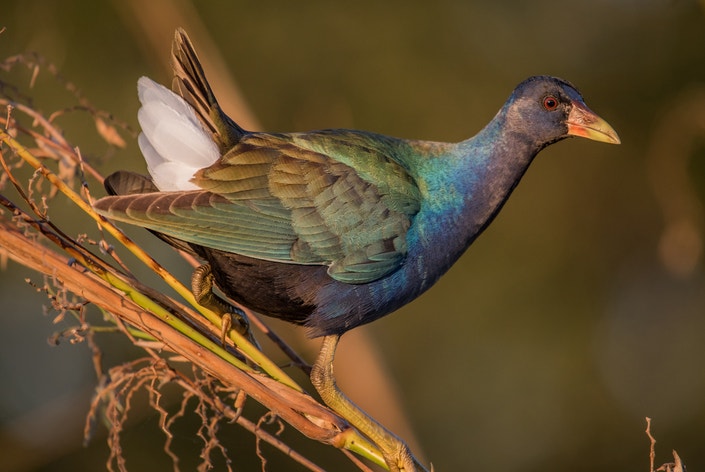Purple Gallinule
At a Glance
This gallinule is a striking bird, big, brightly colored, and noisy. With its strong legs and long toes, it runs about on open shorelines, walks on floating lily pads, and clambers through marshes and waterside trees, flicking its short tail nervously. Nods its head as it swims; flies short distances with legs dangling conspicuously. Found mainly in the southeast and the tropics, but single birds sometimes stray far to the north at any season.
All bird guide text and rangemaps adapted from by Kenn Kaufman漏 1996, used by permission of Houghton Mifflin Harcourt Publishing Company. All rights reserved.
Category
Chicken-like Marsh Birds, Rails, Gallinules, Coots
IUCN Status
Least Concern
Habitat
Coasts and Shorelines, Freshwater Wetlands, Lakes, Ponds, and Rivers, Saltwater Wetlands
Region
Florida, New England, Plains, Southeast, Southwest, Texas
Behavior
Flushes, Running, Swimming
Population
390.000
Range & Identification
Migration & Range Maps
Withdraws in winter from northern parts of breeding range. In United States in winter, found mostly in southern Florida. Strays may reach as far north as Canada at any season; these birds may originate from well to the south of us. Nomadic and migratory within South America as well. Despite seemingly clumsy flight, may travel long distances: strays sometimes cross the Atlantic, and this is one of the most frequent American wanderers to southern Africa.
Description
11-13" (28-33 cm). Adult is mostly purple and green, with pale blue shield above red and yellow bill. Undertail coverts noticeably white; legs bright yellow. Immature much plainer, buff-brown and olive; note bill shape, white undertail coverts.
Size
About the size of a Crow, About the size of a Robin
Color
Blue, Green, Purple, Red, Tan, Yellow
Wing Shape
Long, Pointed
Tail Shape
Short
Songs and Calls
Squawking and cackling; also guttural grunts.
Call Pattern
Falling, Flat
Call Type
Chirp/Chip, Scream, Trill, Whistle
Habitat
Fresh swamps, marshes, ponds. In North America usually in extensive wetlands with still or slow-moving shallow water, lots of dense marsh cover and floating vegetation. In tropics may be found also on smaller ponds, ditches. During migration, individuals may stop over in odd habitats, even in cities.
Sign up for 爆料公社's newsletter to learn more about birds like the Purple Gallinule
Behavior
Eggs
6-8, sometimes 5-10. Buff with brown spots. Incubation is by both sexes, 22-25 days.
Young
May leave nest shortly after hatching, move to 2nd nest. In feeding young, parents are often assisted by other birds (as many as 8); these "helpers" evidently all are previous offspring of breeding pair, and juveniles less than 10 weeks old may help feed newly hatched chicks. Young are capable of flight at roughly 9 weeks.
Feeding Behavior
Forages while walking on land, while climbing through marsh vegetation or waterside shrubs or trees, or while swimming.
Diet
Omnivorous. Eats a wide variety of plant and animal matter, including seeds, fruits, and leaves of aquatic and terrestrial plants, also insects, frogs, snails, spiders, worms, fish. At times, eats the eggs and young of other birds.
Nesting
Breeding behavior has been studied mostly in Costa Rica. May breed at any season in tropics, only in spring and summer in North America. Nest site is in dense marsh growth, over water that is often several feet deep. Nest (built by both sexes) is platform of cattails, grasses, sedges, firmly anchored to standing marsh vegetation, at water level or 1-3' above it. Often build extra nests.
Conservation
Conservation Status
Still widespread in appropriate habitat, but undoubtedly has decreased with draining of swamps, and still vulnerable to loss of more wetlands.

















